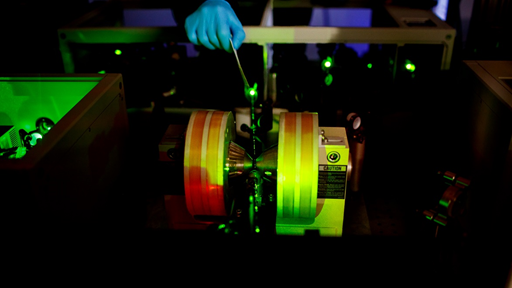Greißel, P.M., Schroeder, Z.W., Thiel, D., Ferguson, M.J., Clark, T., Guldi, D.M., Tykwinski, R.R.
J. Am. Chem. Soc. 2024, 146, 15
Two isomeric pentacene dimers, each linked by a diamantane spacer, have been synthesized. These dimers are designed to provide experimental evidence to support quantum mechanical calculations, which predict the substitution pattern on the carbon-rich diethynyldiamantane spacer to be decisive in controlling the interpentacene coupling. Intramolecular singlet fission (i-SF) serves as a probe for the existence and strength of the electronic coupling between the two pentacenes, with transient absorption spectroscopy as the method of choice to characterize i-SF. 4,9-Substitution of diamantane provides a pentacene dimer (4,9-dimer) in which the two chromophores are completely decoupled and that, following photoexcitation, deactivates to the ground state analogous to a monomeric pentacene chromophore. Conversely, 1,6-substitution provides a pentacene dimer (1,6-dimer) that exhibits sufficiently strong coupling to drive i-SF, resulting in correlated triplet M(T1T1) yields close to unity and free triplet (T1 + T1) yields of ca. 50%. Thus, the diamantane spacer effectively switches “on” or “off” the coupling between the chromophores, based on the substitution pattern. The binary control of diamantane contrasts other known molecular spacers designed only to modulate the coupling strength between two pentacenes.

Greißel, P.M., Schroeder, Z.W., Thiel, D., Ferguson, M.J., Clark, T., Guldi, D.M., Tykwinski, R.R.
J. Am. Chem. Soc. 2024, 146, 15, 10875–10888
Two isomeric pentacene dimers, each linked by a diamantane spacer, have been synthesized. These dimers are designed to provide experimental evidence to support quantum mechanical calculations, which predict the substitution pattern on the carbon-rich diethynyldiamantane spacer to be decisive in controlling the interpentacene coupling. Intramolecular singlet fission (i-SF) serves as a probe for the existence and strength of the electronic coupling between the two pentacenes, with transient absorption spectroscopy as the method of choice to characterize i-SF. 4,9-Substitution of diamantane provides a pentacene dimer (4,9-dimer) in which the two chromophores are completely decoupled and that, following photoexcitation, deactivates to the ground state analogous to a monomeric pentacene chromophore. Conversely, 1,6-substitution provides a pentacene dimer (1,6-dimer) that exhibits sufficiently strong coupling to drive i-SF, resulting in correlated triplet M(T1T1) yields close to unity and free triplet (T1 + T1) yields of ca. 50%. Thus, the diamantane spacer effectively switches “on” or “off” the coupling between the chromophores, based on the substitution pattern. The binary control of diamantane contrasts other known molecular spacers designed only to modulate the coupling strength between two pentacenes.